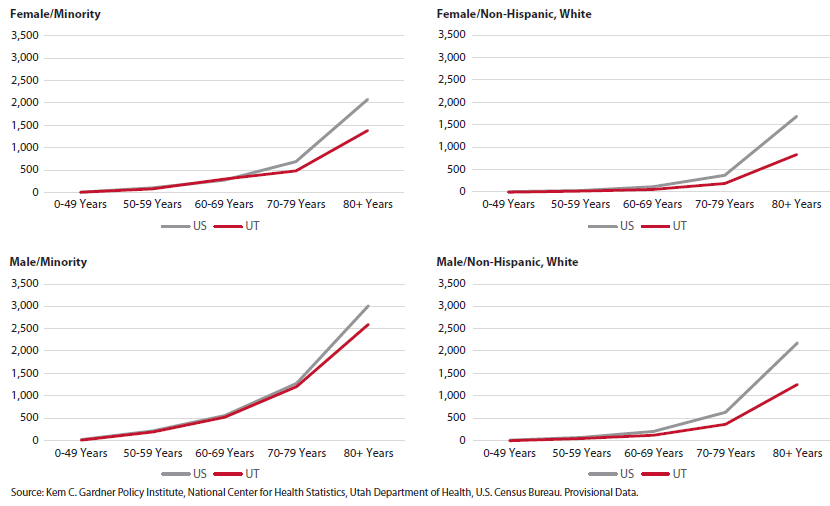Blog Post
Insight: COVID-19 Death Rates and Demographic Factors
By: Mike Hollingshaus and Emily Harris
Oct 12, 2021 – The Kem C. Gardner Policy Institute has released an updated report on Utah’s COVID-19 per-capita-death rates. Our analysis indicates that during the first year of the pandemic, Utah’s structural demographic factors (age, race/ethnic, and sex composition) account for half of Utah’s lower-than-average death rate (compared to the U.S.). The remaining difference is attributable to other factors such as disease epidemiology, institutional and personal behaviors, or social networks.
The graphs below illustrate the COVID-19 death rate differences between Utah and the U.S. across different demographic characteristics. With the exception of two data points, Utah’s death rates are always lower than the U.S.’s death rates.
Provisional Death Rate (per 100k) Comparisons by Age, Sex, and Race/Ethnicity, United States and Utah, April 2020-2021
Covid-19 is generally deadlier for older age groups, males, and racial and ethnic minorities. This means that even if Utah’s Covid-19 response mirrored the U.S.’s response, we would expect Utah to have a lower Covid-19 death rate. However, this report’s decomposition analysis goes past describing the differences, and allows us to quantify how much of these differences are based on Utah’s unique demographic structure alone.
The analysis was challenging for several reasons. By far the largest challenge is that the data are still so fresh and incomplete. This includes not only the COVID-19 statistics, which are underreported at the national level, but also the delayed 2020 decennial census data. Still, we are confident that a large portion of Utah’s lower COVID-19 death rate can be attributed to the demographic hand it has been dealt.
There are many ways to do the analysis, but we chose our method because (1) it is easier to explain the results to a wide audience beyond academia, (2) it could be calculated from aggregated data, which aligns with our mandate as state demographers, and (3) the model is based on solid mathematical principles.
The COVID-19 pandemic has been, and continues to be, tragic in the toll it has taken on lives. Vaccine availability for children will bring vaccines to a large segment of Utah’s population that has been ineligible, which should greatly help with transmission patterns and subsequent deaths. Still, there is clearly more work to do, including years of research ahead to determine the full toll of COVID-19.
Mike Hollingshaus and Emily Harris are Senior Demographers at the Kem C. Gardner Policy Institute.







